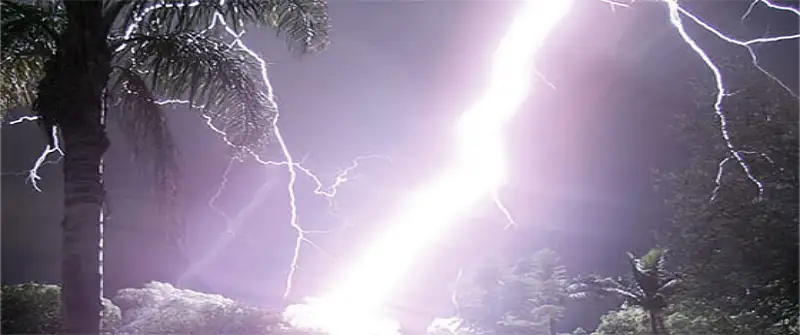Lightning Dangers, Facts, Risks, Tips..
Lightning dangers! Here’s a lightning fact.. Lightning fatalities are highest among those who are fishing, boating, camping, and on the beach. That’s even a higher risk than lightning fatality statistics of golfers (source: NWS statistics).
Way too many became lightning victims as they were in the process of seeking shelter when they were struck.. they waited too long.
Many believe that they are safe from a lightning strike because the thunderstorm is not yet overhead. Don’t let this fool you! (See statistical casualty graph below)
The thing is, when you hear thunder, even a distant rumble, you are already within striking distance of a potentially deadly lightning bolt – even a bolt from the blue. That might sound unrealistic, but it’s scary true.
How far away can you hear thunder? Under good listening conditions, you can hear thunder from a distance of about 10 miles. I have personally found that to be quite accurate. I have often checked my Radar / Lightning app and have measured the distance. That’s also the approximate distance that lightning can strike outward from a thunderstorm! Really!
Unfortunately most people don’t seek shelter until the first lightning strike (and associated Kaboom) is closely upon them. They don’t realize they could be struck even though the thunderstorm is thought to be far enough away.
Lightning Dangers – Risk of Death by Lightning Strike
Risk of death by lightning is HIGHEST when thunderstorms are NOT YET OVERHEAD.
It begins at a distance of about 10 miles away, and peaks just prior to (and during) the thunderstorm initial approach.
The second peak of death-by-lightning is when the thunderstorm is departing.
The following graph by NOAA is quite interesting in this regard. Look at the two lightning casualty peaks around a thunderstorm. It implies that people get struck by lightning because they waited too long (they still felt safe enough) before sheltering. Also, people went back out too early afterwards!
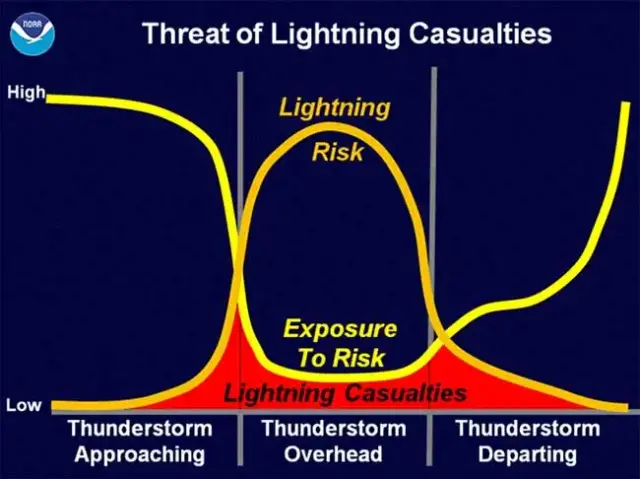
The following NOAA emergency weather alert radio is the best that Midland makes. Quite a nice unit to have.. EVERYONE should have a weather alert radio (and/or an equivalent app on your phone).
>> Midland WR400
(view on amzn)

How do Thunderstorms make Lightning?
Well actually, lightning is seen before the thunder is heard. But here’s a quick explanation:
Causation can be more complicated than this, but, they typically develop when atmospheric conditions are ‘right’ for their development. Perhaps rising warm air heated by the sun (in conjunction with the favorable conditions), growing in height to become towering cumulus clouds.
The bottom, or base of a thunderstorm cloud will develop an electrical charge (typically a negative charge). This occurs from ice particle interaction within the updraft and storm itself.
Additionally, the top of the cloud will develop an electrical charge (positive). We now have an electrical field. When strong enough to break down the air-resistance barrier, a lightning bolt will ‘short circuit’.
This can happen within the cloud, cloud-to-cloud, or between the cloud and ground too. When strong enough, the charge between the two may ‘short circuit’ and go ZAP/BOOM.
Formation of cloud-to-ground lightning. A ‘leader’ or ‘leaders’ form, and may branch out as it/they approach the ground in search of a discharge point.
A conductive ‘streamer’ will then shoot up from an object attached to the ground, usually a high point within the area. It will reach up and meet with the leader to create an often dramatic and powerful return stroke of bright lightning (with it’s associated exploding air Kaboom!).
Negatively charged Lightning Bolt (-)
95% of lightning bolts are ‘negative’. 75% inside the cloud (intra-cloud). 20% cloud-to-ground (CG).
The average ‘negative’ bolt may discharge ~30,000 amps of electrical current and may carry millions of volts, depending on factors.
A Lightning bolt instantly heats the air around it to about 30,000-50,000 degrees-Fahrenheit! That’s hot enough to melt metal and vaporize sand. It expands (explodes) the air around it to create a supersonic shock wave, which is what we hear as thunder.
Positively charged Lightning Bolt (+)
This is the really big one. The extremely powerful but less common ‘positive’ bolt of lightning (about 5% of all strikes). A positively charged lightning bolt will discharge about 5 – 10 times the energy of a ‘negative’ bolt (and last about 10 times longer)!
It typically comes from the top of a very large anvil shaped thunderhead and reaches out for miles (outside the cloud!) ‘into the blue’ before it finds a pathway to ground.
source: The National Severe Storms Laboratory
source: Lightning (Wikipedia)
Lightning Safety Risks and Tips
NO PLACE outside is safe when thunderstorms are in the area.
If you hear thunder, lightning is close enough to strike you.
When you hear thunder, immediately move to safe shelter: a substantial building with electricity or plumbing, or an enclosed metal-topped vehicle with windows up.
Immediately get off elevated areas such as hills, mountain ridges or peaks.
Never lie flat on the ground.
Never shelter under an isolated tree.
Do not use a cliff or rocky overhang for shelter.
Immediately get out and away from ponds, lakes and other bodies of water.
Stay away from objects that conduct electricity (wire fences, power lines, windmills, etc.).
Stay off corded phones, computers and other electrical equipment that put you in direct contact with electricity.
Avoid plumbing, including sinks, baths and faucets.
Stay away from windows and doors, and stay off porches.
Do not lie on concrete floors, and do not lean against concrete walls.
Personal Lightning Safety Tips
The following safety tips are sourced from the National Lightning Safety Institute:
1. PLAN in advance your evacuation and safety measures. When you first see lightning or hear thunder, activate your emergency plan. Now is the time to go to a building or a vehicle. Lightning often precedes rain, so don’t wait for the rain to begin before suspending activities.
2. IF OUTDOORS…Avoid water. Avoid the high ground. Open spaces. Avoid all metal objects including electric wires, fences, machinery, motors, power tools, etc. Unsafe places include underneath canopies, small picnic or rain shelters, or near trees. Where possible, find shelter in a substantial building or in a fully enclosed metal vehicle such as a car, truck or a van with the windows completely shut. If lightning is striking nearby when you are outside, you should:
A. Crouch down. Put feet together. Place hands over ears to minimize hearing damage from thunder.
B. Avoid proximity (minimum of 15 ft.) to other people.
3. IF INDOORS… Avoid water. Stay away from doors and windows. Do not use the telephone. Take off head sets. Turn off, unplug, and stay away from appliances, computers, power tools, & TV sets. Lightning may strike exterior electric and phone lines, inducing shocks to inside equipment.
4. SUSPEND ACTIVITIES for 30 minutes after the last observed lightning or thunder.
5. INJURED PERSONS do not carry an electrical charge and can be handled safely. Apply First Aid procedures to a lightning victim if you are qualified to do so. Call 911 or send for help immediately.
Which State’s Have The Most Lightning?
Florida wins.
South coastal Mississippi/Alabama. Southeast and Northeast Texas. Louisiana. Southeast Oklahoma. Arkansas is in on the action.. See the lightning maps below:
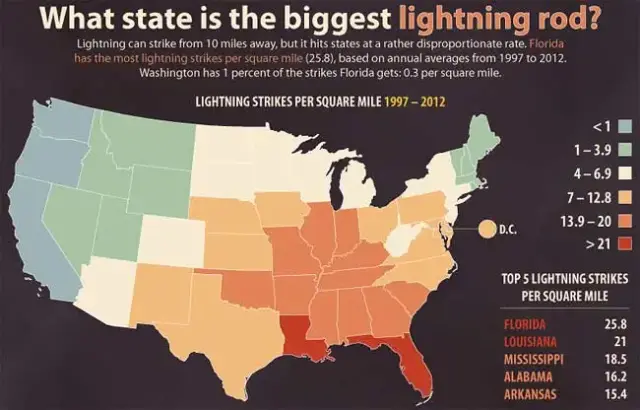
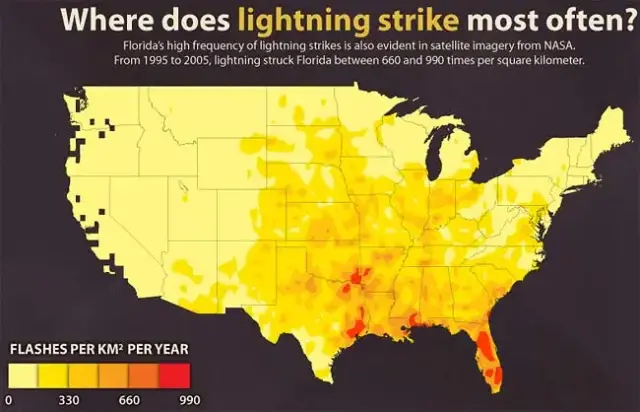
Lightning Facts
There is no safe place outdoors when a thunderstorm is nearby.
The vast majority of lightning victims were going to a safe place, but waited too long before seeking safe shelter.
The channel of air through which lightning passes can be heated to 30,000-50,000 degrees-F, hotter than the surface of the sun!
The rapid heating and cooling of the air near the lightning channel causes a shock wave that results in the sound we know as “thunder”.
According to the NOAA, lightning causes an average of about 50 fatalities and 400 injuries each year in the United States.
Lightning occurs with ALL thunderstorms.
It causes more than $1 billion in insured losses each year.
Lightning Fiction
Rubber tires on a vehicle will protect you from lightning (it’s not the rubber tires). Rather, it’s the steel frame of a hard topped vehicle that provides increased protection if you’re not touching the metal. While you may be injured by lightning if it strikes your car, you are much safer inside a vehicle than outside.
“Heat lightning” occurs after very hot summer days and it’s no threat (is wrong). What is “Heat lightning”? It is a term used to describe lightning from a thunderstorm too far away for the thunder to be heard. It could still be dangerously close.
How to know How Far Away Lightning is
Count the number of seconds between a flash of lightning and the sound of the resulting thunder.
Divide this number by 5 to get an estimate of the distance in miles to the lightning strike. In other words, it’s about 5 seconds per mile.
Lightning Strike USA Density Map
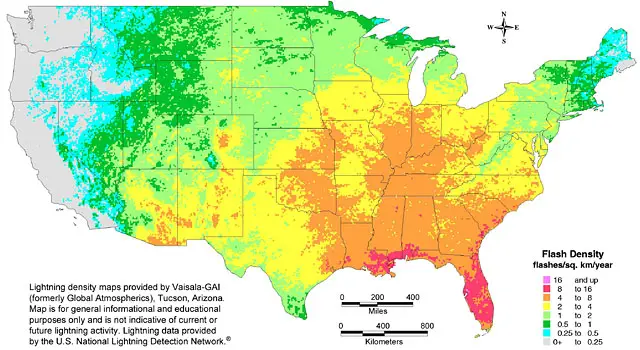
Lightning Strike World Density Map
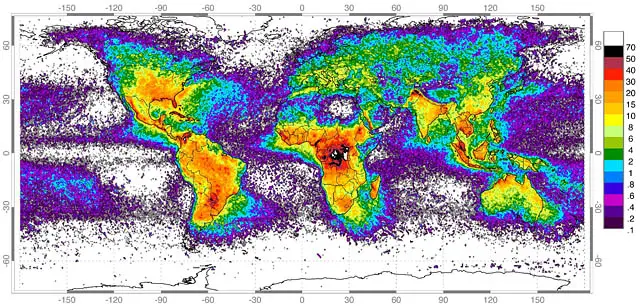
[ Read: Which Weather Alert Radio Should I Get? ]

